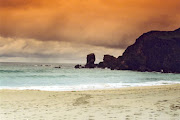In the last article,we saw how the land near the shore was quickly taken,being the most fertile.Expansion out the village followed quickly on both sides of the glen,but these houses were built high up the valley side where the bens afforded some shelter and where the slope helped in the drainage of their lands.There is evidence of outbuildings and small enclosed fields.These houses high on the sides of the "beinn" went much further out than the limits of today's village(above the Mullach Mor on the north side,below Beinn Ia'Ruadh on the south side).The ground further down the slope ,near Allt Dhalamor would be a marsh and incapable of supporting the growth of crops.What these crops were would be pretty limited.The main crop would most certainly be barley.Potatoes and corn(do not confuse with maize)would also have been grown.Barley grew well here,and would be used to bake "aran eorna"(barley bread),to brew ale,and with a precious copper "worm", make a drop or two of the mountain dew.Corn straw could be used as winter fodder with the barley.I was told by an old timer who was often given aran eorna well into the 1900s, that "it tasted bloody awful". Fish from the sea would not usually be available(certainly not in winter)but might be so, if they had access to a boat at Loch Carloway,for example.They had a surprising number of animals in the village,as evidenced by the list of cattle and sheep given for Dalmore in September,1824.
Cattle - 81 Sheep - 278
The cattle would provide milk,and from that, cream,butter,cheese(including crowdie) and finally beef and hide.The sheeps'wool would be spun and used for knitting and weaving(the early Harris Tweed),and finally it would provide them with the original"Antartex coat".Every part of the slaughtered sheep was used in Lewis cuisine from haggis,black and white pudding(marag)and sheeps head and trotters.
As already stated,the population of Dalmore in the 1841 census was 87 persons.
By name the population consisted of ;-
Macleod - 31 Macdonald - 23
Morrison - 16 Maciver - 6
Macneil - 4 Matheson - 4
Maclean - 2 Beaton - 1
A few notes on the above.
1. No.1 Dalmore, at this time,was the land beside the cliffs on the north side of Dalmore bay.This was worked by William Macdonald(65 yrs.) and his wife Marion in 1841,but these people were gone by the next census in 1851.They had seen better times,because in 1814,Wm. Macdonald had been tacksman of both Dalmore and Dalbeg,paying a rental then of £115-5-0.
2.The oldest person on any of the three censuses(1841,1851,1861)was one John Macleod,aged 98 years,who would be around at the time when Bonnie Prince Charlie was feeling not so bonnie hiding from the Redcoats on the Arinish Moor.He finally left ,this great old bodach, to see out his days in Upper Carloway.
3.Of those who chose to emigrate from Dalmore,when the time came,6 people were in their 60s - very sad,I think.
So,this was Dalmore in the 1840s,,living and loving(definitely).growing their crops,tending their cattle and sheep,grinding their barley,having a party,going to church,looking for a minister.With 87 souls in the village,Dalmore was a lively place,yet not recommended for women ,nor the "unco guid". It must have resembled Burn's Mauchline during the Holy Fair.
Famine and eviction would bring their world to an end.Conversation and laughter would be replaced by the bleating of thousands of the caora mhor( the Big Sheep ie. the Cheviot).But Sir James Matheson,their new overlord and great opium trader had exciting plans for Dalmore and the rest of Lewis,his new domain.
Dalmore Daytime

Sandy Beach
Wednesday, 23 January 2008
Subscribe to:
Post Comments (Atom)


No comments:
Post a Comment